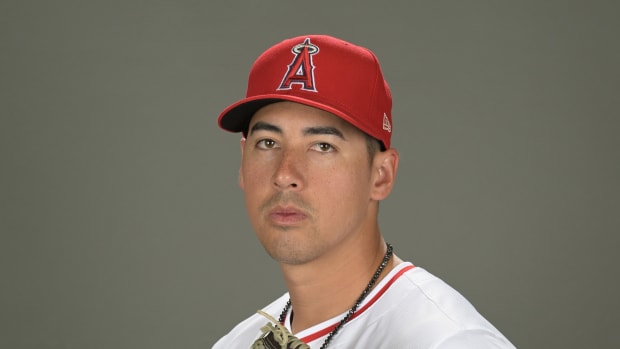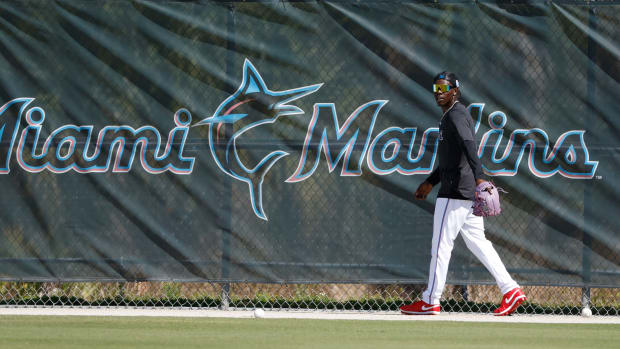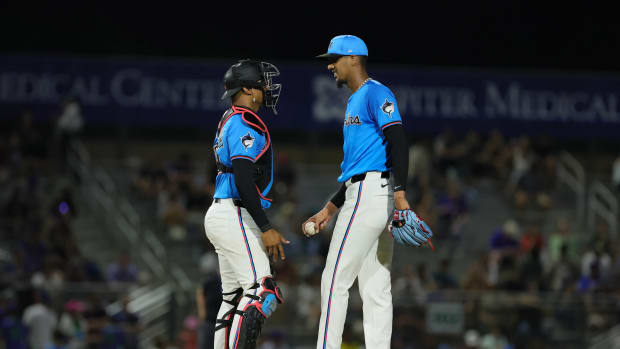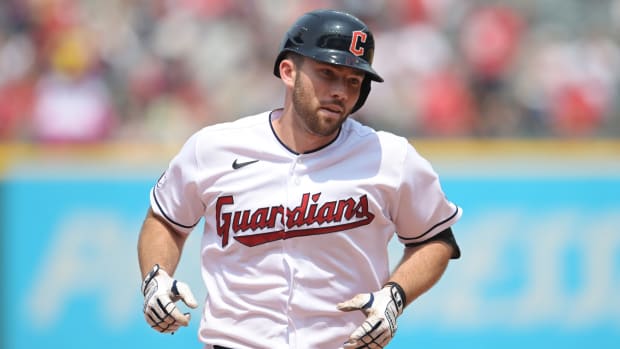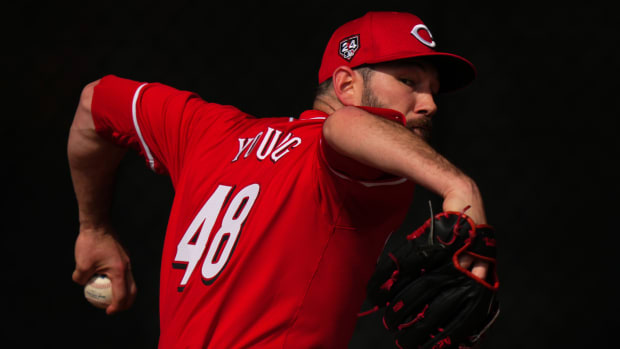Only the Mets Could Find Themselves in This Situation
Welcome back to Nine Innings, SI’s weekly look at what’s fun, cool, and somewhat stupid around the league. Today’s topics include: The Mets dangling a sword over Mickey Callaway’s head; Ian Kinsler earning an FCC fine; Dee Gordon entering the GIF Hall of Fame; and much more.
If you have any feedback, questions or angry rants to send my way, please don’t hesitate to hit me up via email (jon.tayler@simail.com) or Twitter.
This Week In ... The Mets!
Someday this season—perhaps soon, or not for several weeks, or hey, maybe tomorrow—the Mets will fire Mickey Callaway. “He has our full support to lead this team for the foreseeable future,” general manager Brodie Van Wagenen told reporters Monday after Callaway’s crew was swept by the Marlins this weekend, though “foreseeable future” is about as vague and non-committal as you can get. When Callaway eventually does get canned, it’ll be for valid reasons, given the Mets’ struggles and the general sense that he’s in over his head. It’ll also be because this is the Mets, and things like normalcy or stability are foreign concepts that will never take hold with them, like a body rejecting an organ transplant.
To paraphrase Dennis Green: Two months into 2019, the Mets are who they thought they were. They’re a flawed contender with a shallow roster. They’re a team of half measures—one that spent the offseason improving but not doing enough, giving off an air of competence but so far falling short. Under Van Wagenen, the new front office signed several players who have helped, but it also eschewed bigger, better and seemingly easier solutions for less effective options that cost less.
New York came into the season content with Jason Vargas as its fifth starter despite his 5.77 ERA in 2018 and with next-to-zero rotation depth despite the presence of him and perennial MRI machine resident Steven Matz. The team passed on Manny Machado and Bryce Harper, instead opting for question marks like Robinson Canó. It added elite talent like Edwin Díaz, but at the cost of prospects in order to save money. Perhaps most importantly, it decided to keep Callaway despite the fact that he was an ousted GM’s managerial pick and despite his uninspiring rookie campaign.
The Mets would have been justified in firing Callaway had they done so. They didn’t, with Van Wagenen selling the idea of him being the right fit. That feels more and more like eyewash given that, with Memorial Day still a week away, Callaway looks as good as gone. His head will be the first one to roll for a Mets team that has underperformed, but if he’s going to go that quickly, then he should have gone back in November, when Van Wagenen was hired. The new GM should have picked his own manager. He didn’t, because what else do you expect from the Mets at this point?
Callaway’s wobbly job status wasn’t even Monday’s biggest news out of Queens, where reporters learned that Yoenis Cespedes—who’s been out since last July due to heel surgery—broke an ankle in a fall at his Florida ranch. When it rains on the Mets, it pours, and they never have an umbrella. But this combination of tragic farce and bizarre process is perfectly on brand for this team, and it has been for years, and it likely will be, like Callaway, for the foreseeable future. And that shouldn’t surprise anyone, if you consider the one constant in all of this. So long as Fred and Jeff Wilpon hold the keys to the kingdom, then you shouldn’t expect any of this nonsense to change.
This Week In … Vladimir Guerrero Jr.!
Oh me of little faith. Last week, my hopes wavered in our lovely big baseball boy, given his slow start to the season. My Vlad Jr. spirit was willing, but his bat was weak. And though I knew that he was simply adjusting to a new and difficult league, my heart was uneasy. Had he been hyped up too much? Was he not as good as advertised?
Well, the very same night last week’s column came out, here’s what he did.
That was just the start. Vlad Jr. homered twice more last week, going 7-for-21 over six games with four dingers, nine runs driven in, three walks and just one strikeout. The slow start is dead. Now begins the reign of terror. Or, to put it more succinctly:
This Week In … Telling Your Fans to F--- Off!
Heading into last Thursday’s game against the Pirates, veteran Padres second baseman Ian Kinsler was hitting just .171, and fans at Petco Park were giving him a hard time. He turned around weeks of frustration with one swing—and also unloaded quite a bit of it on the Friar faithful.
Yep: After hitting a go-ahead, three-run homer, Kinsler celebrated with a nifty bat flip and by telling all assembled to get bent with a hearty “F--- you, f--- all of you.” He even added some extra spice in the dugout.
After the game, Kinsler said that his outburst wasn’t directed at the fans, because of course he’s going to say that, what other option does he have? Still, the next time he hits a cathartic dinger at home, I hope this is his reaction as he crosses home plate.
This Week In … Situational Awareness!
The Brewers—namely, starter Gio Gonzalez—made a pretty bad base-running blunder against the Phillies. With the bases loaded and no one out, Ryan Braun tapped a ball to third baseman Sean Rodriguez. Gonzalez, standing on third, had no choice but to run home—except he didn’t, instead retreating to the bag. All Rodriguez had to do at this point to turn a double play was step on third to get Lorenzo Cain, who was running from second, and then throw home to retire Gonzalez.
But Cain was one step ahead. Noticing Gonzalez stuck at third, he pointed home—not to try to get his starter to move, but to get Rodriguez to throw there and forget about him. And amazingly, Rodriguez did just that.
The result: One out instead of two, the bases still loaded, and three runs scored that inning, all thanks to Cain’s Jedi mind trick. This is not the double play you are looking for.
This Week In … Perfect Reactions!
I’m happy to announce that baseball now has its own Alonzo Mourning GIF.
It comes courtesy of Dee Gordon, who dropped this short one-act play on us during last Tuesday’s Mariners-Twins game.
The reason behind Gordon’s initial confusion and eventual understanding was a prolonged debate between umpires. In short: reliever Cory Gearrin did a toe tap that may or may not have been illegal, and it took a while for the men in blue to sort that out. This is Gordon learning about it and reacting to it, but the moment isn’t what matters.
It’s that, just like Manning, Gordon has progressed through at least two or three stages of the Kübler-Ross model in roughly four seconds—and, in the process, gifting us a wonderful new reaction GIF for any and all confusing yet ultimately pointless outcomes in life.
This Week In … Mascots Getting What They Deserve!
When we last left Blooper, the hideous blanched hot dog that the Braves call a mascot, he was trying to swindle Manny Machado out of $300 million. Apparently, he tried to pull a similar trick on the Cardinals’ Jose Martinez last Wednesday, only to meet some painful resistance.
I can’t say exactly why Martinez is going after Blooper, aside from the fact that Blooper is a demon that came out of the Hell portal in DOOM. But safe to say that whatever Blooper did, Martinez is right to thrash him, as he’s an ill-made, spiteful creature full of envy and low cunning.
This Week In … Thriving In Retirement!
By the end of his long career, Jered Weaver was averaging 83.6 mph on his four-seam fastball, or about 10 mph slower than Walker Buehler’s changeup. Unsurprisingly, that kind of stuff is no good against major league hitters. But even though his cheese isn’t funky enough to get by big league bats, he showed over the weekend that he’s still got plenty of gas to flummox your everyday amateurs.
The best part of this—beyond the fact that Weaver’s catcher is, randomly enough, 14-year veteran Mike Lieberthal (in full gear, no less)—is just how hard and fast the ball looks coming out of Weaver’s hand despite him throwing probably no harder than 80. It’s a nice reminder that, old or not, major leaguers are way, way, way better than you and me at this whole baseball thing.
This Week In … Who Needs Craig Kimbrel?
Every week until he’s signed, I’ll take a look at which teams need Craig Kimbrel, one of the best relievers in baseball, the most, and declare one the winner.
Quick: Name two Twins relievers. Hell, see if you can name one.
Give up? Most of you probably did the second I asked you to think about Minnesota’s bullpen. It’s a largely anonymous bunch, comprised of a bunch of white righthanders who throw in the low to mid 90s with sliders. There’s a Taylor, a Tyler and a Trevor (at one point, there were two Trevors), as well as a Matt and a Mike. There’s also Blake, Austin and Ryne, to give it a full “suburban preschool class” vibe. And it’s a group that, despite being as diverse as a Republican-held state senate, has for the most part performed well. Blake Parker has excelled as the closer. Ryne Harper and Taylor Rogers have shined as his setup men. Trevor May has handled the middle innings with aplomb.
You’re probably thinking to yourself, that doesn’t sound like a crew that needs Craig Kimbrel. You’re right: The Twins could survive 2019 just fine without him. Sure, they’ve blown a few leads here and there, but they’re also 30–16 and leading the AL Central by 4 1/2 games. Kimbrel would be a luxury here, not a necessity.
But to me, being a luxury is exactly what makes him a necessity for Minnesota. Splurging on an expensive closer is precisely what good teams should do because of the decisive advantage he presents in the crucial high-leverage innings they’ll routinely be in. Plenty of teams with faltering bullpens like the Nationals or Braves need Kimbrel too, but there’s a lot else wrong with those clubs that he can’t fix. The Twins also have issues to address, but they’re already in a good, strong place. Upgrade, then, to an even better position, and prepare for the tougher battles ahead, with the name-brand option.
Also receiving votes: Can you believe it’s almost Memorial Day and I’m still doing this bit? I really thought it’d be long over by now.
This Week In … Old Baseball Cards!
Each week, I’ll pluck a random baseball card out of a pile of 1980s, 90s and 2000s cards I have at my desk, then write a quick little take on the player in question. This week’s entry: Bob Howry, pitcher, Chicago White Sox (Upper Deck 1999).
“Anyone who thinks we can catch Cleveland is crazy.” So said White Sox owner Jerry Reinsdorf after his team more or less gave up on the 1997 season at that year’s trade deadline, dealing Wilson Alvarez, Roberto Hernandez and Danny Darwin to the Giants for a half-dozen prospects, including Howry. “The White Flag Trade,” as it came to be known, was as hard a punt as possible despite straits less dire than Reinsdorf described. Chicago was only 3 ½ games behind the Indians in the AL Central at the time, and Cleveland finished with just 86 wins, or six ahead of the Sox. (The Indians did end up winning the pennant that year, though, so maybe Reinsdorf was right.)
Still, from the ashes of that self-inflicted arson came some good for Chicago—namely, Howry and Keith Foulke. The former spent his first four-plus seasons as a setup man for the latter in Chicago, then began the peripatetic bounce that marks the careers of all good-but-not-great relievers: Boston, Cleveland, Chicago (on the North Side), Arizona and—fittingly—San Francisco.
Twelve years after being dealt away, Howry returned to the Giants. None of his fellow trade-mates were left in baseball by that point: He’d outlasted Foulke by four years, and of those exchanged for him, the ageless Hernandez was the final one standing, playing his final season in 2007 at 42 years old. It’s worth noting that, while Hernandez pitched well for the Giants in ’97, both Alvarez and Darwin were terrible; the White Flag Trade ended up being a blunder for San Francisco, which lost two good relievers for little return.
Baseball has a tendency to close loops like that, though, folding in on itself like a pretzel. It’s not quite the Prodigal Son, heading home to a grateful father, but Howry nonetheless came back. San Francisco probably wishes that he’d never left.

































